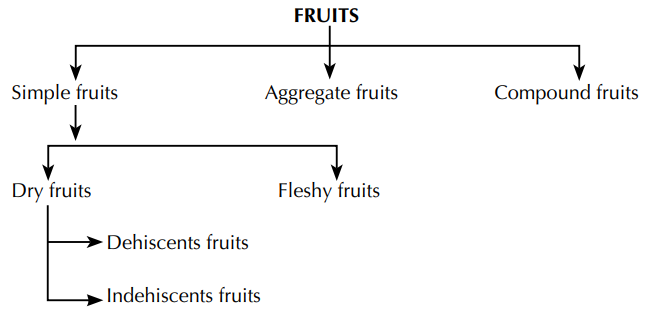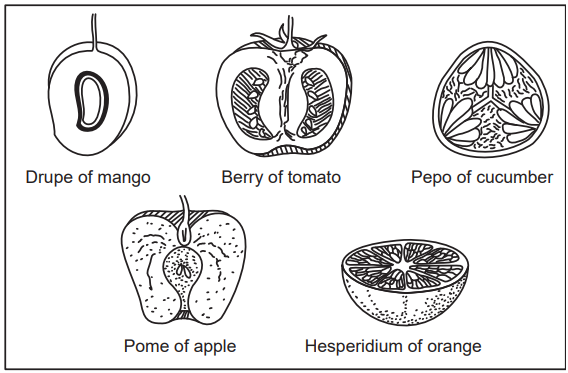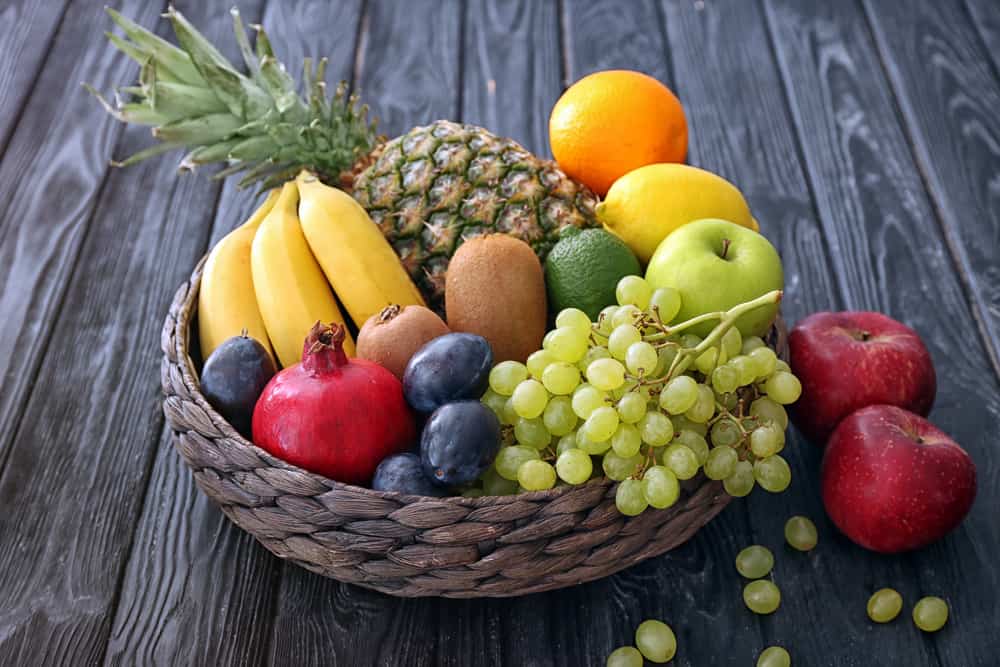Morphology of Fruits: Phanerogams are said to be matured when they reach the flowering stage. The ovules of the flowers after fertilization get converted into seeds, whereas the ovary wall develops further to form the protective covering over the seed, which is known as fruit. In botany, this particular coating is also called pericarp.
Pericarp consists of three different layers, one after the other as:
- Epicarp: The outermost coating of the pericarp may be thin or thick.
- Mesocarp: A layer in between epicarp and endocarp, and maybe pulpy or made up of spongy parenchymatous tissue.
- Endocarp: The innermost layer of the pericarp, may be thin or thick, or even woody.
The fruits don’t need to have seeds. If the ovules do not fertilize, the seedless fruits are formed. Depending upon the number of carpels present in the flowers, and other structures, the fruits fall into (1) simple fruits, (2) aggregate fruits, and (3) compound fruits.
Simple fruits:
Formed from the single carpel or syncarpous gynoecium. Once again depending upon the mesocarp, whether it is dry or fleshy, they are classified as dry fruits and fleshy fruits. Dry fruits are further sub-classified into dehiscent and indehiscent fruits.
Aggregate fruits:
These fruits get formed from many carpels or apocarpous gynoecium, e.g. raspberry.
Compound fruits:
In this particular case, many more flowers come together and form the fruits, e.g. figs, pineapple.

False fruits:
Sometimes it so happens that apart from the ovary and the other floral parts like the thalamus, receptacle or calyx grow and form the part of the fruit, known as false fruit or pseudocarp. Following are a few examples of pseudocarp in which other parts of the flower forming an important part of the fruits are shown in the bracket. Strawberry (thalamus), cashew nut (peduncle and thalamus), apple (thalamus), marking nut (peduncle), and rose (thalamus)
I. Dehiscent capsular fruits:
1. Legume or pod: It is a dry monocarpellary fruit developing from a superior ovary, dehiscing by both the margins, i.e. senna, tamarind, pea.
2. Capsule: It is a dry one to many-chambered fruit, developing from superior or poly carpellary ovary dehiscing in various forms, i.e. cardamon, cotton, datura, lobelia, colchicum, digitalis, poppy.
3. Follicle: Similar to legumes and dehisces at one margin only, i.e. rauwolfia, anise, calotropis.
4. Siliqua: A dry, two-chambered fruit, developing from bicarpellary ovary, multi seeded. It dehisces from base upwards as in radish mustard, etc.
II. Indehiscest fruits:
1. Achene: A dry, one-chambered, one-seeded fruit developed from the superior monocarpellary ovary. The pericarp is free of the seed coat, i.e. clemantis, rose.
2. Caryopsis or grain: Small, dry, one-seeded fruits, developing from the simple pistil, pericarp fused with seed coat as in maize, rice, bamboo.
3. Nut: Dry, one-seeded fruits developing from the superior ovary, pericarp hard and woody, i.e. areca nut, marking nut, cashew nut.
4. Samara: Dry, one- or two-seeded, winged fruit from superior bi- or tricarpellary ovary, i.e. Dioscorea, shorea, etc.
5. Schizocarp: These are further divided into two subclasses.
- Lomentum: In this type of pod of legume is partitioned into one-seeded compartments as observed in acacia, groundnut, cassia fistula.
- Cremocarp: Dry, two-chambered fruit, developing from an inferior bicarpellary ovary. Splitting into two, indehiscent one-seeded pieces are called mericarps, i.e. coriander, cumin, fennel, dill, etc.
Fleshy fruits:
1. Drupe (Stone fruit): A fleshy one or more seeded fruit, with pericarp, well-differentiated into epicarp, fleshy mesocarp, and hard endocarp as in mango, olive, coconut, etc.
2. Berry: A fleshy, many-seeded fruit developed from a superior, single carpel, i.e. tomato, guava, grapes, banana.
3. Pepo: Pulpy, many-seeded fruit developing from one- or three celled inferior ovaries, i.e. cucumber gourd, colocynth, watermelon.
4. Pome: Fleshy, one- or more-celled syncarpous fruit. The fleshy, part is the thalamus, while actual fruit lies inside, e.g. apple, pear.
5. Hesperidium: A superior, many-seeded fleshy fruit endocarp forming chambers; epicarp and mesocarp fused to form a skin, e.g. orange, lemon.

Uses of fruits:
- Apart from the main source of food grains, i.e. wheat, jowar, fruits are also used for their high sugar value, minerals, and vitamins.
- Fleshy fruits like, papaya, mango, apple are used commercially as a source of pectin.
- Bayberry wax and olive oil are obtained industrially from fruits only.
- Several fruits like chilies, black pepper caraway, and cumin are used on large scale for the preparation of spices.
Make sure you also check our other amazing Article on : Morphology of Inflorescence
